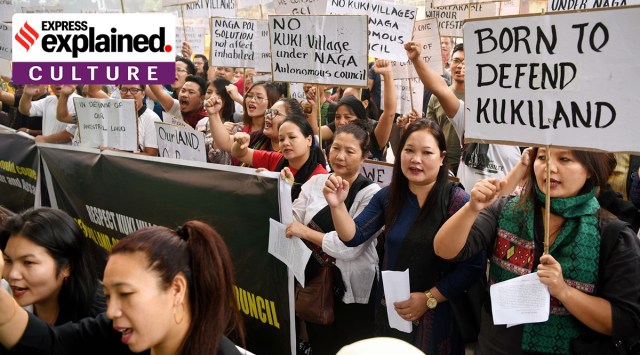The demand for a Kuki homeland, its history and rationale
The demand for a separate “Kukiland” dates back to the late 1980s, when the first and largest of the Kuki-Zomi insurgent groups, the Kuki National Organisation (KNO), came into being. The demand has surfaced periodically ever since.
 Kuki people and students hold play cards as they shout slogans during a protest against the reported inclusion of Kuki ancestral land in the proposed Naga Autonomous council in Manipur and Assam, in October 2020. (ANI file photo/R Raveendran)
Kuki people and students hold play cards as they shout slogans during a protest against the reported inclusion of Kuki ancestral land in the proposed Naga Autonomous council in Manipur and Assam, in October 2020. (ANI file photo/R Raveendran) Days after clashes between Manipur’s Kuki-Zomi tribes and the majority Meitei community left more than 70 people dead, the state’s 10 Kuki-Zomi MLAs demanded “a separate administration under the Constitution”, saying “our people can no longer exist under Manipur… [and] to live amidst the Meiteis again is as good as a death…”.
The tribal lawmakers, including two ministers in the N Biren Singh government, met Home Minister Amit Shah in Delhi on Monday, a day after Shah had a meeting with the Chief Minister, four state ministers — all Meitei — and Maharaja Leishemba Sanajaoba, the titular king of Manipur and Rajya Sabha member from the state.
While Biren has stressed that “the territorial integrity of Manipur will be protected”, the ethnic clashes have led to the resurfacing of the demand for a separate administration, which had subsided following peace negotiations between Kuki-Zomi insurgent groups and the government.
A Kuki homeland
The demand for a separate “Kukiland” dates back to the late 1980s, when the first and largest of the Kuki-Zomi insurgent groups, the Kuki National Organisation (KNO), came into being. The demand has surfaced periodically ever since.
In 2012, as it became increasingly clear that the demand for a separate Telangana state would be accepted, an organisation called the Kuki State Demand Committee (KSDC) announced a movement for Kukiland. KSDC had been calling occasional strikes and economic bandhs even earlier, blocking highways, and not letting goods enter Manipur.
The KSDC claimed 12,958 sq km, more than 60% of Manipur’s 22,000 sq km area, for “Kukis and Kukiland’’. The territory of “Kukiland” included the Sadar Hills (which surround the Imphal valley on three sides), the Kuki-dominated Churachandpur district, Chandel, which has a mix of Kuki and Naga populations, and even parts of Naga-dominated Tamenglong and Ukhrul.
The KSDC and sections of the Kuki-Zomi community have maintained that the tribal areas “are yet to be a part of the Indian Union”. They have contended that after the defeat of the king of Manipur in the 1891 Anglo-Manipur war, the kingdom became a British protectorate, but the lands of the Kuki-Zomi were not part of the agreement.
The KSDC also said that unlike the Naga demand for a separate country, it was only seeking a separate state within the Indian Union.
The agitation did have an impact — the Congress government of Chief Minister Okram Ibobi Singh declared, in the face of strong opposition from the United Naga Council, the Kuki-dominated Sadar Hills, part of the Naga-dominated Senapati district, as a separate district.
‘Land of freedom’
The Kukiland demand is rooted in the idea of the Zale’n-gam, or ‘land of freedom’.
Some Kuki-Zomi people, especially the insurgent groups, contest the dominant narrative that their ancestors were brought from the Kuki-Chin hills of Burma by the British political agent and settled around the Imphal valley to protect the Manipur kingdom from the plundering Naga raiders of the north. They also contest the idea of the nomadic origins of the Kuki-Zomi.
In the opposing narrative, the Kuki Zale’n-gam sprawled across a large part of India’s Northeast and contiguous areas in present day Myanmar — and under the Treaty of 1834, the British handed over a significant chunk of this land to Burma to appease the Ava or Burmese king.
According to the KNO, the Zale’n-gam included the area up to the Chindwin river in Myanmar and covered the bordering regions of India, the areas around the Nantalit river in northern Myanmar, and stretched to the Chin state in the south. In India, the Kuki homeland included the hill districts of Manipur, including the Naga areas, Kanjang, Akhen, Phek, and parts of Dimapur in Nagaland, Karbi-Anglong, North Cachar Hills, and Halflong in Assam, and Tripura, as well as parts of the Chittagong Hill Tracts in Bangladesh.
Over the years though, this imagination of the homeland has shrunk to that of a state created out of the hill areas of Manipur, including those dominated by the Naga tribes.
KNO’s manifesto
In a book published in 2018, KNO president P S Haokip wrote about the alleged neglect of the hill districts of Manipur, in particular those dominated by the Kuki people such as Churachandpur and Chandel, by the Meitei-dominated state government. (The World of Kuki People)
Haokip also complained that Naga insurgent groups have for decades attempted to grab Kuki lands. The demand for a separate “Kukiland” intensified after the Naga-Kuki clashes of 1993, in which, according to the KNO, more than 1,000 Kukis were killed, and many times that number were displaced. The KNO has alleged that the Meiteis did not come to the help of Kukis at the time.
The manifesto of the KNO pledges to “restore the ancestral Kuki territory to its rightful status”.
- 01
- 02
- 03
- 04
- 05






































